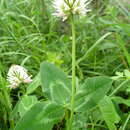Physical Description
provided by USDA PLANTS text
Perennial, Herbs, Plants with rhizomes or suckers, Nodules present, Stems erect or ascending, Stems or branches arching, spreading or decumbent, Stems less than 1 m tall, Stems solid, Stems or young twigs glabrous or sparsely glabrate, Stems or young twigs sparsely to densely hairy, Leaves alternate, Leaves petiolate, Stipules conspicuous, Stipules green, triangulate to lanceolate or foliaceous, Stipules persistent, Stipules clasping stem at the base, Stipules adnate to petiole, Leaves compound, Leaves palmately 2-3 foliate, Leaflets dentate or denticulate, Leaflets 3, Leaves glabrous or nearly so, Leaves hairy on one or both surfaces, Inflorescences racemes, Inflorescences globose heads, capitate or s ubcapitate, Inflorescence axillary, Bracteoles present, Flowers zygomorphic, Calyx 5-lobed, Calyx glabrous, Calyx hairy, Petals separate, Corolla papilionaceous, Petals clawed, Petals white, Petals pinkish to rose, Petals red, Banner petal narrow or oblanceolate, Wing petals narrow, oblanceolate to oblong, Wing petals auriculate, Wing tips obtuse or rounded, Keel tips obtuse or rounded, not beaked, Stamens 9-10, Stamens diadelphous, 9 united, 1 free, Filaments glabrous, Style terete, Style persistent in fruit, Fruit a legume, Fruit stipitate, Fruit unilocular, Fruit indehiscent, Fruit oblong or ellipsoidal, Fruit orbicular to subglobose, Fruit or valves persistent on stem, Fruit enclosed in calyx, Fruit glabrous or glabrate, Fruit 1-seeded, Fruit 2-seeded, Seeds cordiform, mit-shaped, notched at one end, Seed surface smooth, Seeds olive, brown, or black.
Trifolium ambiguum: Brief Summary
provided by wikipedia EN
Trifolium ambiguum, the kura clover or Caucasian clover, is a species of flowering plant in the family Fabaceae. It is native to Ukraine, Crimea, south European Russia, the northern Caucasus, Turkey, Iraq, and Iran, and has been introduced to New South Wales. Planted for forage, once established it is tolerant of close grazing, and is also useful for honey production.
- license
- cc-by-sa-3.0
- copyright
- Wikipedia authors and editors

